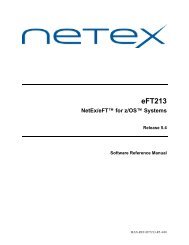Software Reference Manual - NetEx
Software Reference Manual - NetEx
Software Reference Manual - NetEx
You also want an ePaper? Increase the reach of your titles
YUMPU automatically turns print PDFs into web optimized ePapers that Google loves.
mod<br />
BUF<br />
BUFLEN<br />
BFUBIT<br />
BDTMOD<br />
This parameter is the name of the block module.<br />
This parameter defines the start of the block. For a receiving block module, the block information<br />
will start at the beginning of the BUF array. For a sending block module, the block to be sent over<br />
NETEX should be placed starting at the beginning of the BUF array.<br />
This parameter specifies the length of the block in bytes. When the block module is called for the<br />
first time, BUFLEN will have the maximum logical block length permissible with the user’s BLOCK<br />
parameter. If the block module dislikes this value it can change the value of BUFLEN (and hence the<br />
BFX buffer size) before returning to the control module. On subsequent calls, the receiving block<br />
module will obtain the physical block length in this parameter; sending block modules should specify<br />
the length of the outgoing block with this variable.<br />
This parameter is the NETEX unused bit count. This value is principally used for sending or receiving<br />
precise amounts of file information to systems whose word sizes are not a multiple of eight bits.<br />
If the block module is a sending block module, then this value will be zero when the module is called.<br />
If it wants to use the unused bit count facility, then it should place a nonzero value in the field.<br />
NETEX will perform algebra on the datamode and total number of useful bits sent and will provide a<br />
resultant length and unused bit count to be delivered to the receiving block module.<br />
The receiving block module will have this value set on entry. It may use this field or ignore it.<br />
This parameter is the DATAMODE field that is used to support the optional code conversion and assembly/disassembly<br />
features of NETEX. Each time a transmitting block module is called, the<br />
BDTMOD field will contain the DATAMODE that was negotiated at connection time based on the<br />
system types and the MODE= parameters specified by both BFX implementations. The block module<br />
may leave this value unchanged, or it may supply a DATAMODE in this field that will be used to<br />
transfer the data buffer supplied by this call.<br />
A receiving block module will have this value set to the incoming DATAMODE of the block that is<br />
delivered to the block module.<br />
BUFLEV<br />
This parameter is the same as the BUFLEV parameter for record modules.<br />
MSG<br />
This parameter specifies an area that allows alphabetic information to be returned to the calling control<br />
module. If the block module wants to return a message, it should place a string of EBCDIC character<br />
information in this parameter. The maximum length of the message is 128 bytes. Unlike the record<br />
module, this message will only be logged locally; messages sent between BFX programs must<br />
be accommodated in the protocol implemented by the block modules.<br />
MSGLEN<br />
MSGLEV<br />
This parameter indicates the length of the message returned by the block module. The length passed<br />
to the block module is zero; if a zero MSGLEN is returned, it is assumed that no message is present.<br />
Page 72 Appendix A: User Modules MAN-REF-H211-05















